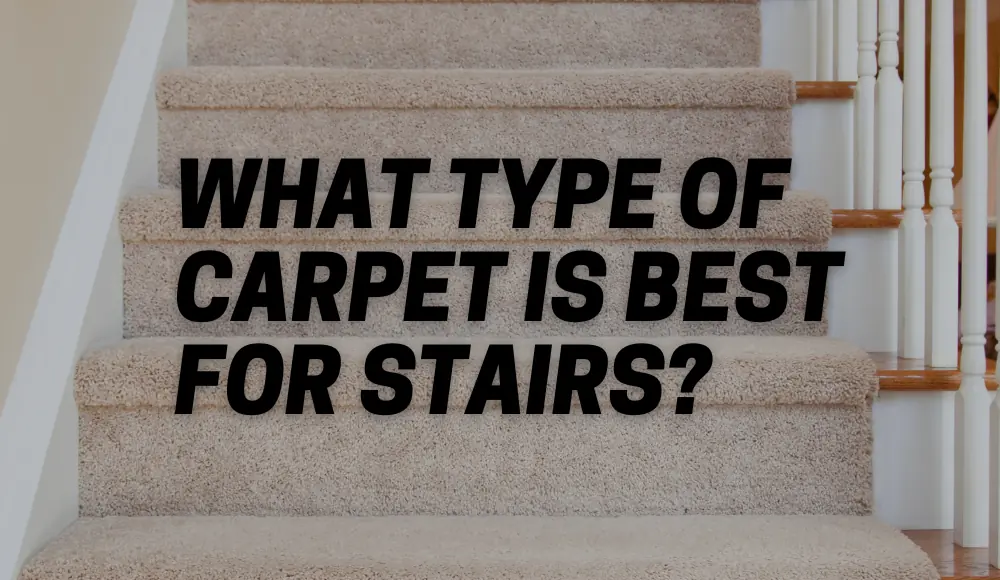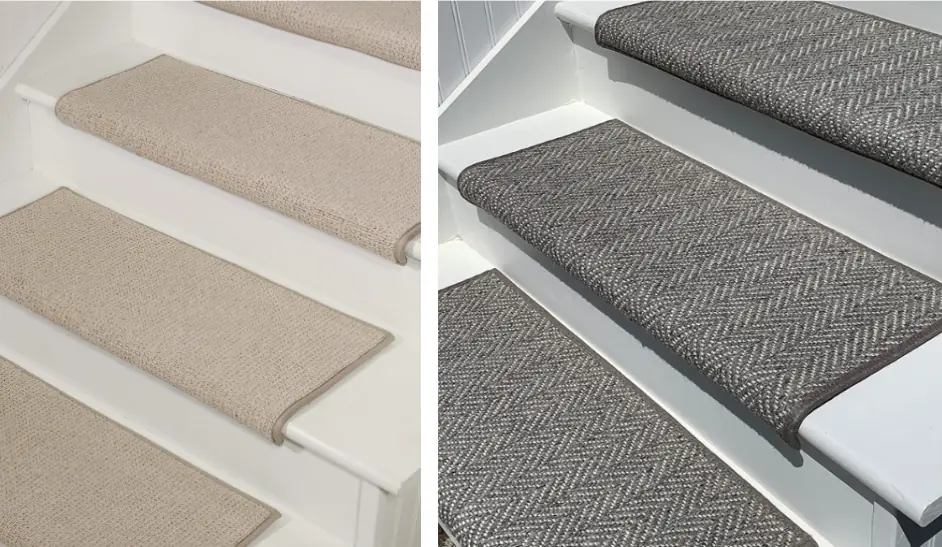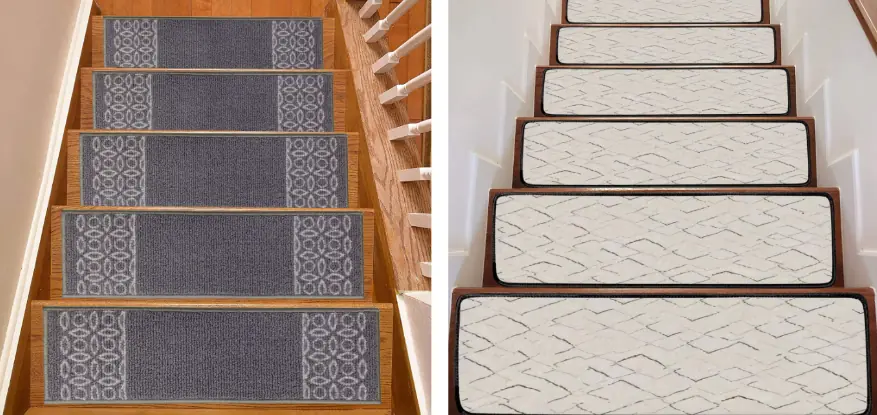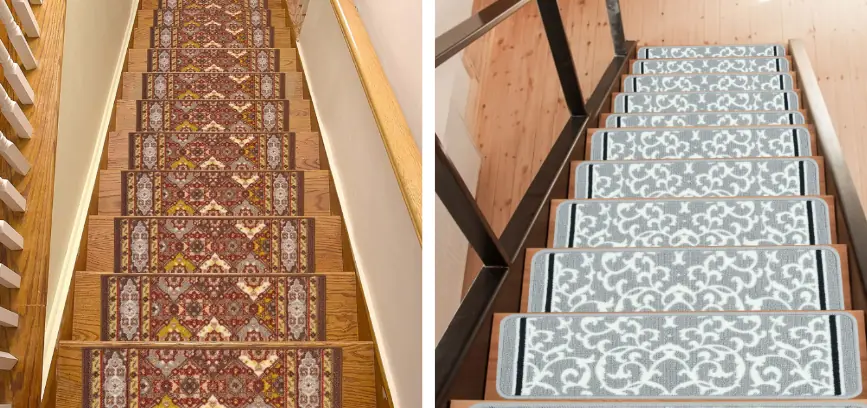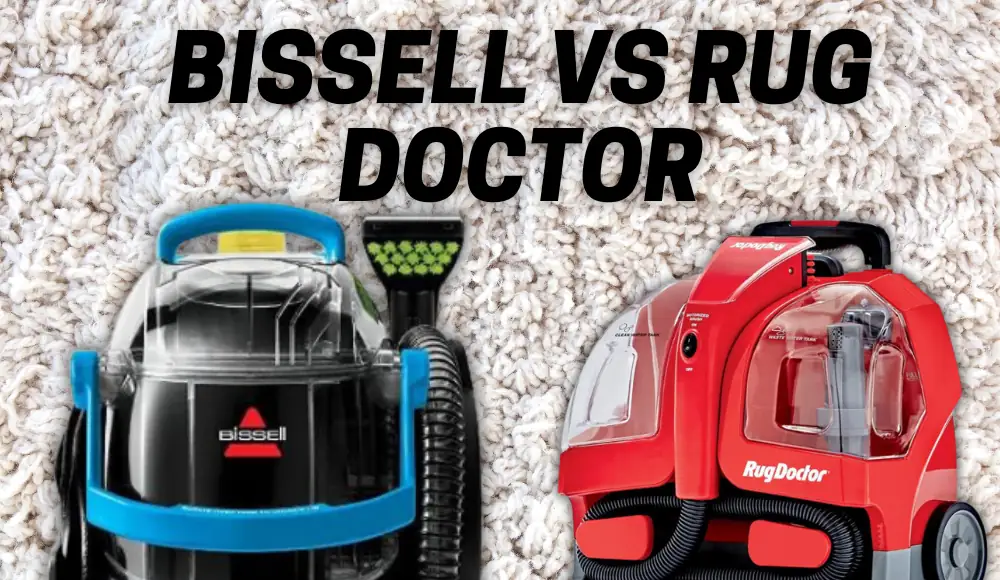When it comes to choosing the right carpet for your stairs, there are several factors to consider. One of the key aspects is finding a trendy stair carpet that not only enhances the aesthetics of your home but also provides durability and safety. In this article, we will explore the different aspects to understand what type of carpet is best for stairs, including pile height, color options, traffic considerations, and more.
So, let’s dive in and discover what makes a stair carpet truly trendy and suitable for your needs.
Do You Need Different Carpet for Stairs?
Choosing the right carpet for stairs is crucial, as stairs tend to experience higher foot traffic and wear compared to other areas of your home.
While you may be tempted to use the same carpet throughout your entire house, it’s important to note that stairs have unique requirements.
The constant footfall and the nature of the stairs demand a carpet that can withstand the test of time.
Carpet for stairs: Ideas
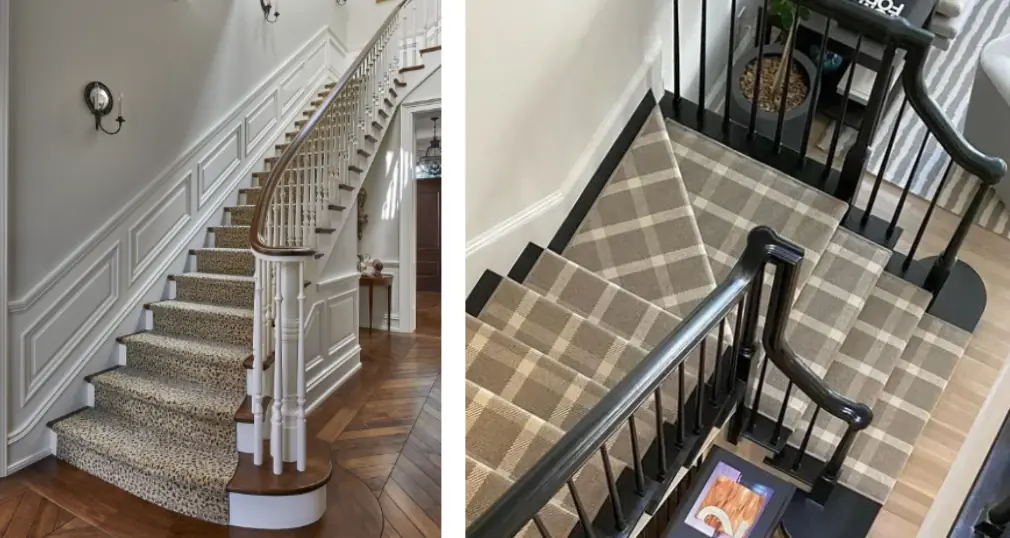
Is High or Low Pile Carpet Better for Stairs?
The choice between high pile and low pile carpet for stairs is an important one. High-pile carpets, with their longer, softer fibers, provide a plush and luxurious feel.
However, they can be more prone to matting and wear in high-traffic areas like stairs. On the other hand, low-pile carpets, with shorter, denser fibers, offer better durability and are easier to clean.
Considering the heavy foot traffic on stairs, a low-pile carpet is generally a more practical choice.
Best Color Carpet for Stairs and Landing
The color of your stair carpet can greatly impact the overall look and feel of your home.
When it comes to choosing the best color for your stairs and landing, there are a few factors to consider. Light-colored carpets can make a space appear larger and more open, while dark-colored carpets can add depth and create a cozy atmosphere.
Ultimately, the choice of color depends on your personal preference and the existing color scheme of your home.
Carpet for Stairs and Landing Pictures
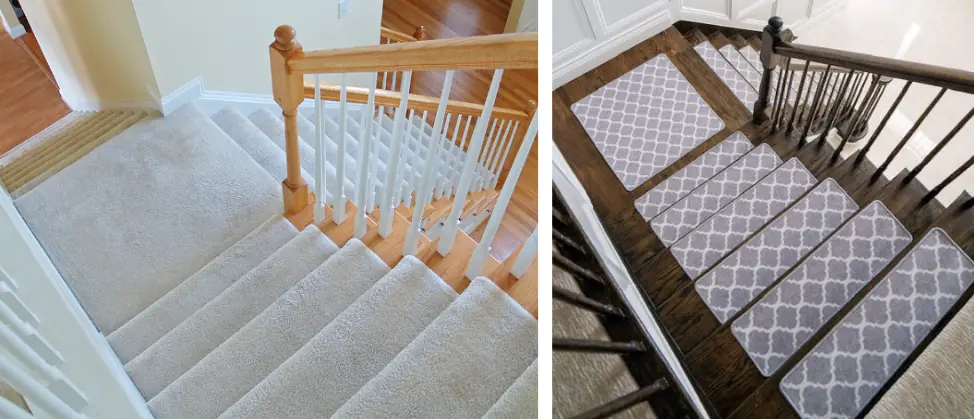
Should Stairs Have Dark or Light Carpet?
Deciding between dark or light carpet for your stairs depends on your specific requirements.
Dark carpet can be forgiving when it comes to hiding dirt and stains, which can be a plus for high-traffic areas like stairs.
On the other hand, light-colored carpets can brighten up the space and create an illusion of openness.
If you have pets or young children, you might want to consider a carpet color that effectively conceals dirt and stains.
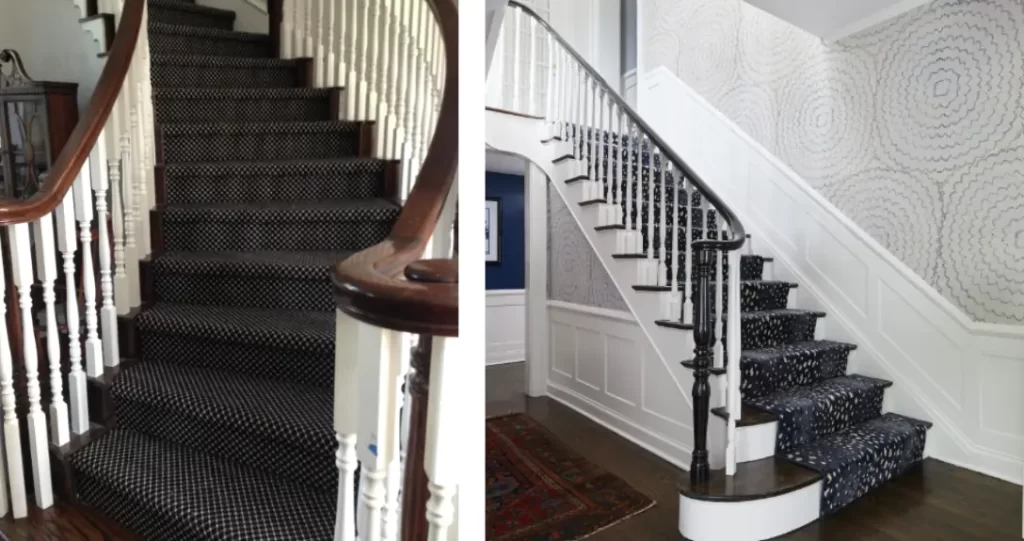
What is the Best Carpet for Stairs High Traffic?
Choosing a carpet that can withstand high traffic on stairs is crucial for long-term durability.
For high-traffic areas like stairs, consider carpets made from durable materials such as nylon or wool.
Nylon carpets are known for their exceptional strength and resilience, making them an ideal choice for stairs. Wool carpets, although more expensive, are also highly durable and offer excellent stain resistance.
Is Berber Carpet Good for Stairs?
Berber carpet, known for its looped construction, can be a good option for stairs. The looped fibers in berber carpets provide extra durability and help conceal footprints and vacuum marks.
However, it’s important to choose a berber carpet with a tight loop construction to prevent snags or trips on the stairs.
Additionally, ensure that the carpet pad used beneath the berber carpet provides sufficient cushioning for added comfort and safety.
How Thick Should Carpet Be for Stairs?
The thickness of the carpet for stairs should strike a balance between comfort and safety. While a thick carpet can provide a plush feel underfoot, it may also pose a tripping hazard.
What is the best thickness of carpet for stairs?
It’s recommended to opt for a carpet with a medium thickness that offers both comfort and stability.
Additionally, using a high-quality carpet pad beneath the carpet can enhance the overall feel and durability while providing extra cushioning.
What is Best for Non-Slippery Carpet on Stairs?
Safety is paramount when it comes to choosing a non-slippery carpet for stairs.
To prevent slips and falls, consider carpets with a textured or patterned surface. These textures provide added grip and traction, reducing the risk of accidents on the stairs.
Additionally, you can also explore the option of using stair carpet treads or runners, which offer additional stability and safety.
What Type of Carpet is Best for Stairs and Landing?
Consistency in carpet type between stairs and the landing can create a cohesive and visually appealing look.
When selecting a carpet for stairs and the landing, consider durability, color, and texture.
Opting for the same type of carpet throughout these areas ensures a seamless transition and a unified aesthetic. This not only enhances the overall appearance of your home but also makes maintenance and cleaning more convenient.
Durability and safety are key considerations since these areas tend to experience heavy foot traffic and are prone to wear and tear.
Here are some options to consider:
- Nylon: Nylon is a popular choice for carpets due to its durability and resilience. It can withstand heavy use and is resistant to stains and fading. Look for a tightly woven nylon carpet with a dense pile for better performance on stairs.
- Wool: Wool is a natural fiber known for its luxurious feel and durability. It is naturally resistant to stains and is flame-retardant, making it a safe choice for stairs. Wool carpets tend to be more expensive than synthetic options but offer excellent performance.
- Polyester: Polyester carpets are known for their softness and affordability. While not as durable as nylon or wool, they can still be a good option for stairs and landings with moderate foot traffic. Look for polyester carpets with a higher pile density for better wear resistance.
- Polypropylene/Olefin: Polypropylene, also known as olefin, is a synthetic fiber that is highly resistant to stains, fading, and moisture. It is a budget-friendly option and can be a good choice for high-traffic areas like stairs. However, it may not be as soft or durable as nylon or wool.
In addition to the carpet type, consider the pile height and density.
It’s important to note that regardless of the carpet type you choose, using a high-quality carpet pad or underlay is crucial for added comfort and longevity.
Ultimately, the best carpet for your stairs and landing will depend on your specific needs, budget, and personal preferences.
Industrial grade carpet for stairs
When it comes to industrial settings, stairs often require a durable and hard-wearing carpet to withstand heavy foot traffic, potential spills, and frequent cleaning.
Here are a few options to consider for industrial-grade carpeting on stairs:
- Commercial-Grade Nylon: Nylon carpets are widely recognized for their durability, resistance to stains, and ability to handle high-traffic areas. Look for a commercial-grade nylon carpet with a tight weave and high-density pile. These carpets are designed to withstand heavy use and are often treated with stain-resistant coatings.
- Polypropylene/Olefin: Polypropylene is a synthetic fiber known for its resistance to stains, moisture, and fading. It is often used in commercial settings, including industrial environments. Polypropylene carpets are relatively affordable and can handle heavy foot traffic. They are also resistant to mold and mildew, making them suitable for environments with higher moisture levels.
- Carpet Tiles: Carpet tiles are modular carpet squares that can be individually replaced if damaged. They are a popular choice for industrial settings because of their durability and ease of maintenance. Look for carpet tiles specifically designed for high-traffic areas or commercial applications. They often have a low pile height and are made from durable materials like nylon or polypropylene.
- Berber Carpet: Berber carpets are characterized by their looped construction and dense weave. They are known for their durability and resistance to wear and tear. Berber carpets made from nylon or wool can be a good choice for industrial staircases. However, be cautious with looped carpets as they can catch on shoes or objects and potentially cause accidents.
When selecting an industrial-grade carpet for stairs, it’s crucial to consider safety features as well. Look for carpets with slip-resistant backings or underlays to reduce the risk of accidents on stairs.
Additionally, ensure that the carpet meets relevant fire safety regulations for industrial environments.
It is advisable to consult with carpet manufacturers or suppliers that specialize in commercial or industrial-grade carpets. They can provide specific recommendations based on your requirements and offer guidance on the most suitable options for your industrial setting.
Where to Buy Carpet for Stairs?
When it comes to purchasing a trendy stair carpet, you have several options available.
Consider visiting local carpet stores where you can explore different types, colors, and textures in person. This allows you to feel the carpet and get a better idea of its quality.
Alternatively, online retailers, such as Amazon, provide a wide range of options, often with detailed product descriptions and customer reviews to guide your decision.
Just make sure to choose a reputable seller with positive feedback and return policies.
Maintenance Tips
Vacuuming Regularly is Key
Keeping your stair carpet clean starts with regular vacuuming. Depending on how much traffic your stairs see, you may need to vacuum once a week or more frequently.
Use the proper attachments and settings to thoroughly clean all areas of the carpet, including corners and edges. Make sure to remove any loose dirt or debris before using any cleaning products.
Spot Cleaning Techniques
If you spill something on your stair carpet, it’s important to quickly clean it up before it has a chance to set in.
- Blot up as much of the spill as possible with a clean cloth or paper towel.
- Don’t rub the stain, as that can push it further into the carpet fibers.
- Instead, use a specialized cleaning product designed for carpets and follow the instructions carefully.
- Be sure to test the product in an inconspicuous area first to make sure it doesn’t damage or discolor the carpet.
Deep Cleaning Options
Even with regular maintenance, your stair carpet will eventually need a deep cleaning to remove built-up dirt and stains. You can hire a professional cleaning service or rent a carpet cleaner and do it yourself.
If you choose to do it yourself, be sure to follow all instructions carefully and use appropriate safety gear such as gloves and eye protection. Move furniture out of the way so you can clean all areas of the stairs thoroughly.
Tips for Dealing with Pet Stains
If you have pets in your home, accidents are inevitable at some point.
If your pet has an accident on your stair carpet, act quickly to blot up as much of the mess as possible using paper towels or newspaper (which won’t leave behind fibers like cloth).
Then use an enzymatic cleaner specifically designed for pet stains (available at many pet stores) according to the instructions. These cleaners break down the proteins in pet urine and feces, making it easier to remove the stain and odors.
Protecting Your Stair Carpet
To keep your stair carpet in good shape for as long as possible, there are a few things you can do. Use mats or rugs in high-traffic areas to reduce wear and tear on the carpet.
Avoid wearing shoes on your stairs, as they can track in dirt and other debris that can damage the carpet fibers. And consider having your stair carpet professionally sealed to protect against spills and stains.
Conclusion
Choosing the right carpet for your stairs is a crucial decision that can greatly impact the overall look, feel, and durability of your home.
By considering factors such as pile height, color options, traffic considerations, and safety features, you can find a trendy stair carpet that meets your requirements.
Whether you opt for a low pile, durable nylon carpet, or a textured Berber carpet, prioritize the safety and longevity of your stairs while maintaining a visually appealing and cohesive design.
With the right choice, your stairs can become a stylish focal point, elevating the aesthetic appeal of your home for years to come.
